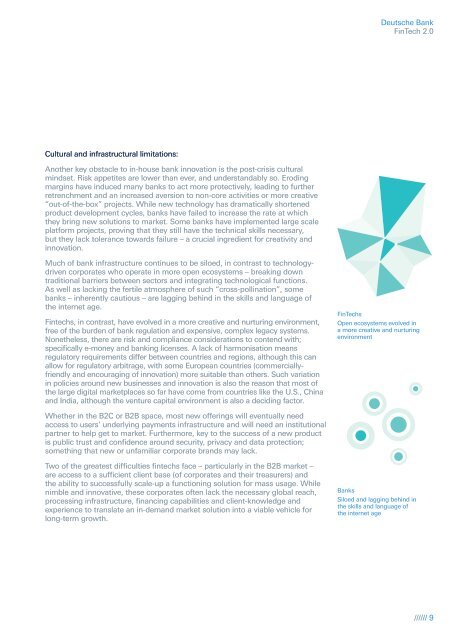FinTech 2.0
YKHHI
YKHHI
Create successful ePaper yourself
Turn your PDF publications into a flip-book with our unique Google optimized e-Paper software.
Deutsche Bank<br />
<strong>FinTech</strong> <strong>2.0</strong><br />
Cultural and infrastructural limitations:<br />
Another key obstacle to in-house bank innovation is the post-crisis cultural<br />
mindset. Risk appetites are lower than ever, and understandably so. Eroding<br />
margins have induced many banks to act more protectively, leading to further<br />
retrenchment and an increased aversion to non-core activities or more creative<br />
“out-of-the-box” projects. While new technology has dramatically shortened<br />
product development cycles, banks have failed to increase the rate at which<br />
they bring new solutions to market. Some banks have implemented large scale<br />
platform projects, proving that they still have the technical skills necessary,<br />
but they lack tolerance towards failure – a crucial ingredient for creativity and<br />
innovation.<br />
Much of bank infrastructure continues to be siloed, in contrast to technologydriven<br />
corporates who operate in more open ecosystems – breaking down<br />
traditional barriers between sectors and integrating technological functions.<br />
As well as lacking the fertile atmosphere of such “cross-pollination”, some<br />
banks – inherently cautious – are lagging behind in the skills and language of<br />
the internet age.<br />
Fintechs, in contrast, have evolved in a more creative and nurturing environment,<br />
free of the burden of bank regulation and expensive, complex legacy systems.<br />
Nonetheless, there are risk and compliance considerations to contend with;<br />
specifically e-money and banking licenses. A lack of harmonisation means<br />
regulatory requirements differ between countries and regions, although this can<br />
allow for regulatory arbitrage, with some European countries (commerciallyfriendly<br />
and encouraging of innovation) more suitable than others. Such variation<br />
in policies around new businesses and innovation is also the reason that most of<br />
the large digital marketplaces so far have come from countries like the U.S., China<br />
and India, although the venture capital environment is also a deciding factor.<br />
<strong>FinTech</strong>s<br />
Open ecosystems evolved in<br />
a more creative and nurturing<br />
environment<br />
Whether in the B2C or B2B space, most new offerings will eventually need<br />
access to users’ underlying payments infrastructure and will need an institutional<br />
partner to help get to market. Furthermore, key to the success of a new product<br />
is public trust and confidence around security, privacy and data protection;<br />
something that new or unfamiliar corporate brands may lack.<br />
Two of the greatest difficulties fintechs face – particularly in the B2B market –<br />
are access to a sufficient client base (of corporates and their treasurers) and<br />
the ability to successfully scale-up a functioning solution for mass usage. While<br />
nimble and innovative, these corporates often lack the necessary global reach,<br />
processing infrastructure, financing capabilities and client-knowledge and<br />
experience to translate an in-demand market solution into a viable vehicle for<br />
long-term growth.<br />
Banks<br />
Siloed and lagging behind in<br />
the skills and language of<br />
the internet age<br />
////// 9


